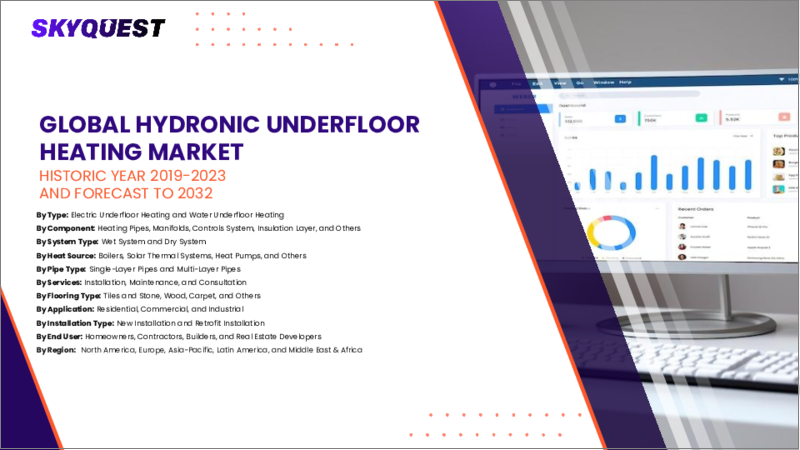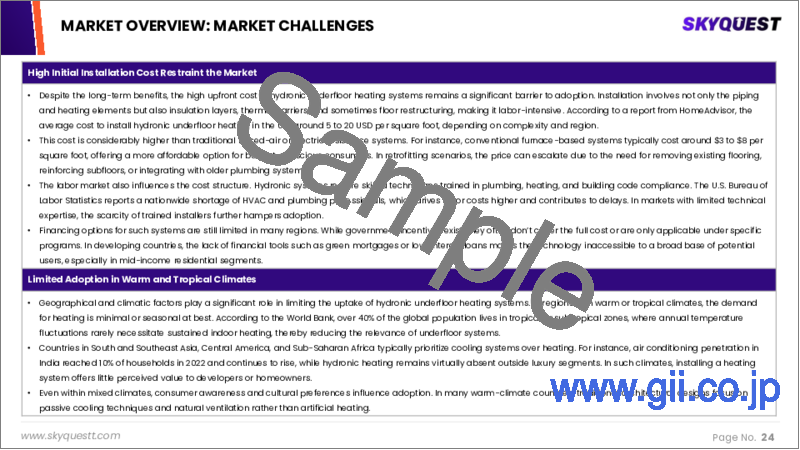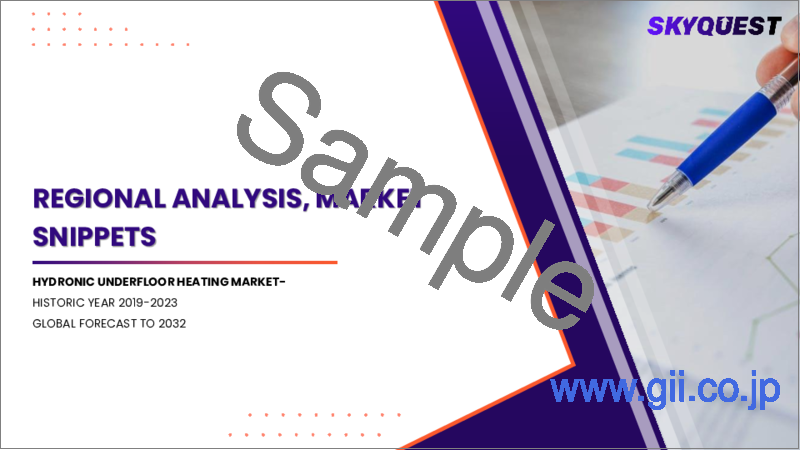|
|
市場調査レポート
商品コード
1640032
温水式床暖房の市場規模、シェア、成長分析:製品別、タイプ別、サービス別、技術別、コンポーネント別、用途別、材料タイプ別、設置タイプ別、地域別 - 産業予測 2025~2032年Hydronic Underfloor Heating Market Size, Share, Growth Analysis, By Type, By Product, By Services, By Technology, By Component, By Application, By Material Type, By Installation Type, By Region - Industry Forecast 2025-2032 |
||||||
|
|||||||
| 温水式床暖房の市場規模、シェア、成長分析:製品別、タイプ別、サービス別、技術別、コンポーネント別、用途別、材料タイプ別、設置タイプ別、地域別 - 産業予測 2025~2032年 |
|
出版日: 2025年01月21日
発行: SkyQuest
ページ情報: 英文 202 Pages
納期: 3~5営業日
|
全表示
- 概要
- 目次
温水式床暖房の世界市場規模は2023年に44億米ドルと評価され、予測期間(2025-2032年)のCAGRは6.1%で、2024年の46億7,000万米ドルから2032年には75億米ドルに成長する見通しです。
世界の持続可能性の重視が、エネルギー効率が高く環境に優しい暖房ソリューション、特に温水式床暖房システムの需要を促進しています。建設業界では、エネルギー効率の向上を目指した持続可能な慣行がますます採用されるようになっており、この分野は大きな成長を遂げています。また、技術の進歩により、これらのシステムの効率性と信頼性が向上し、消費者にとってより魅力的なものとなっています。特に費用対効果の高いソリューションが求められる商業環境では、温水式床暖房の用途が拡大しており、市場の拡大をさらに後押ししています。さらに、エネルギー効率の高い暖房システムの使用を促進する政府の優遇措置が需要を押し上げると予想されます。持続可能な電化製品を取り巻く消費者の意識の高まりが、温水式床暖房ソリューションの長期的な販売軌道を支えると思われます。
目次
イントロダクション
- 調査の目的
- 調査範囲
- 定義
調査手法
- 情報調達
- 二次データと一次データの方法
- 市場規模予測
- 市場の前提条件と制限
エグゼクティブサマリー
- 世界市場の見通し
- 供給と需要の動向分析
- セグメント別機会分析
市場力学と見通し
- 市場概要
- 市場規模
- 市場力学
- 促進要因と機会
- 抑制要因と課題
- ポーターの分析
主な市場の考察
- 重要成功要因
- 競合の程度
- 主な投資機会
- 市場エコシステム
- 市場の魅力指数(2024年)
- PESTEL分析
- マクロ経済指標
- バリューチェーン分析
- 価格分析
温水式床暖房市場規模:タイプ別& CAGR(2025-2032)
- 市場概要
- 水式
- 電気式
温水式床暖房市場規模:製品別& CAGR(2025-2032)
- 市場概要
- パイプ
- 多岐管
- コントロール
- 断熱
- サーモスタット
温水式床暖房市場規模:サービス別& CAGR(2025-2032)
- 市場概要
- 設置
- 保守
- 相談
温水式床暖房市場規模:技術別& CAGR(2025-2032)
- 市場概要
- 放射熱暖房
- スマート暖房
- ゾーニングシステム
温水式床暖房市場規模:コンポーネント別& CAGR(2025-2032)
- 市場概要
- 熱源
- ポンプ
- 熱交換器
温水式床暖房市場規模:用途別& CAGR(2025-2032)
- 市場概要
- 住宅用
- 商業用
- 産業用
- 機関用
温水式床暖房市場規模:材料タイプ別& CAGR(2025-2032)
- 市場概要
- ペックス
- ポリプロピレン
- 銅
温水式床暖房市場規模:設置タイプ別& CAGR(2025-2032)
- 市場概要
- 新築
- 改造
温水式床暖房市場規模:エンドユーザー別& CAGR(2025-2032)
- 市場概要
- 住宅所有者
- 請負業者
- ビルダー
- 不動産開発業者
温水式床暖房市場規模:地域別& CAGR(2025-2032)
- 北米
- 米国
- カナダ
- 欧州
- ドイツ
- スペイン
- フランス
- 英国
- イタリア
- その他欧州地域
- アジア太平洋地域
- 中国
- インド
- 日本
- 韓国
- その他アジア太平洋地域
- ラテンアメリカ
- ブラジル
- その他ラテンアメリカ地域
- 中東・アフリカ
- GCC諸国
- 南アフリカ
- その他中東・アフリカ
競合情報
- 上位5社の比較
- 主要企業の市場ポジショニング(2024年)
- 主な市場企業が採用した戦略
- 市場の最近の動向
- 企業の市場シェア分析(2024年)
- 主要企業の企業プロファイル
- 会社概要
- 製品ポートフォリオ分析
- セグメント別シェア分析
- 収益の前年比比較(2022-2024)
主要企業プロファイル
- Uponor Corporation(Finland)
- Danfoss A/S(Denmark)
- Robert Bosch GmbH(Germany)
- Mitsubishi Electric Corporation(Japan)
- Daikin Industries, Ltd.(Japan)
- Honeywell International Inc.(USA)
- Siemens AG(Germany)
- Schneider Electric SE(France)
- Polypipe Group plc(UK)
- Warmup Plc(UK)
- Resideo Technologies, Inc.(USA)
- nVent Electric plc(UK)
- Emerson Electric Co.(USA)
- Schluter-Systems KG(Germany)
- Amuheat Pty Limited(Australia)
- Hurlcon Hydronic Heating(Australia)
- Warmboard, Inc.(USA)
- H2O Heating Pty Ltd(Australia)
- Hunt Heating(Australia)
結論と推奨事項
Global Hydronic Underfloor Heating Market size was valued at USD 4.4 billion in 2023 and is poised to grow from USD 4.67 billion in 2024 to USD 7.5 billion by 2032, growing at a CAGR of 6.1% during the forecast period (2025-2032).
The global emphasis on sustainability is driving the demand for energy-efficient and eco-friendly heating solutions, notably hydronic underfloor heating systems. As the construction industry increasingly adopts sustainable practices aimed at enhancing energy efficiency, this sector is experiencing significant growth. Technological advancements are also enhancing the efficiency and reliability of these systems, making them more appealing to consumers. The rising application of hydronic underfloor heating in commercial settings, particularly where cost-effective solutions are sought, further propels market expansion. Additionally, favorable government incentives promoting the use of energy-efficient heating systems are expected to boost demand. Growing consumer awareness surrounding sustainable appliances will support the long-term sales trajectory of hydronic underfloor heating solutions.
Top-down and bottom-up approaches were used to estimate and validate the size of the Global Hydronic Underfloor Heating market and to estimate the size of various other dependent submarkets. The research methodology used to estimate the market size includes the following details: The key players in the market were identified through secondary research, and their market shares in the respective regions were determined through primary and secondary research. This entire procedure includes the study of the annual and financial reports of the top market players and extensive interviews for key insights from industry leaders such as CEOs, VPs, directors, and marketing executives. All percentage shares split, and breakdowns were determined using secondary sources and verified through Primary sources. All possible parameters that affect the markets covered in this research study have been accounted for, viewed in extensive detail, verified through primary research, and analyzed to get the final quantitative and qualitative data.
Global Hydronic Underfloor Heating Market Segmental Analysis
Global Hydronic Underfloor Heating Market is segmented by Type, Product, Services, Technology, Component, Application, Material Type, Installation Type, End User and region. Based on Type, the market is segmented into Water-based and Electric. Based on Product, the market is segmented into Pipes, Manifolds, Controls, Insulation and Thermostats. Based on Services, the market is segmented into Installation, Maintenance and Consultation. Based on Technology, the market is segmented into Radiant Heating, Smart Heating and Zoning Systems. Based on Component, the market is segmented into Heat Source, Pump and Heat Exchanger. Based on Application, the market is segmented into Residential, Commercial, Industrial and Institutional. Based on Material Type, the market is segmented into PEX, Polypropylene and Copper. Based on Installation Type, the market is segmented into New Construction and Retrofit. Based on End User, the market is segmented into Homeowners, Contractors, Builders and Real Estate Developers. Based on region, the market is segmented into North America, Europe, Asia Pacific, Latin America and Middle East & Africa.
Driver of the Global Hydronic Underfloor Heating Market
The global hydronic underfloor heating market is significantly propelled by the increasing emphasis on energy efficiency among consumers and businesses alike. As individuals and organizations strive to lower energy expenditures and adopt sustainable practices, hydronic underfloor heating systems emerge as an effective solution. These systems not only contribute to reduced energy consumption but also help in decreasing carbon emissions, allowing users to maintain comfort without sacrificing efficiency. This dual benefit of cost savings and environmental responsibility is a key driver of market expansion, as more people recognize the value of innovative heating solutions in their quest for sustainability.
Restraints in the Global Hydronic Underfloor Heating Market
One of the significant restraints affecting the global hydronic underfloor heating market is the initial installation cost. Compared to conventional heating systems, installing hydronic underfloor heating requires a more substantial financial investment due to the need for specialized equipment and skilled labor. While the long-term energy savings can eventually compensate for these expenses, the high upfront costs deter many potential consumers from embracing this technology. This hesitancy to invest a large sum at the outset is likely to hinder the widespread adoption of hydronic underfloor heating systems in the foreseeable future, limiting market growth.
Market Trends of the Global Hydronic Underfloor Heating Market
The Global Hydronic Underfloor Heating market is witnessing a significant trend towards the integration of smart technology, which is poised to revolutionize the industry. This convergence enables users to monitor and control their heating systems remotely, utilizing smartphones and virtual assistants for enhanced convenience and efficiency. As smart home concepts gain traction, hydronic heating solutions that seamlessly blend with these technologies are anticipated to drive market growth. This shift not only improves user experience but also opens new business avenues for market players, positioning smart hydronic systems as a critical component in the future of energy-efficient heating solutions.
Table of Contents
Introduction
- Objectives of the Study
- Scope of the Report
- Definitions
Research Methodology
- Information Procurement
- Secondary & Primary Data Methods
- Market Size Estimation
- Market Assumptions & Limitations
Executive Summary
- Global Market Outlook
- Supply & Demand Trend Analysis
- Segmental Opportunity Analysis
Market Dynamics & Outlook
- Market Overview
- Market Size
- Market Dynamics
- Drivers & Opportunities
- Restraints & Challenges
- Porters Analysis
- Competitive rivalry
- Threat of substitute
- Bargaining power of buyers
- Threat of new entrants
- Bargaining power of suppliers
Key Market Insights
- Key Success Factors
- Degree of Competition
- Top Investment Pockets
- Market Ecosystem
- Market Attractiveness Index, 2024
- PESTEL Analysis
- Macro-Economic Indicators
- Value Chain Analysis
- Pricing Analysis
Global Hydronic Underfloor Heating Market Size by Type & CAGR (2025-2032)
- Market Overview
- Water-based
- Electric
Global Hydronic Underfloor Heating Market Size by Product & CAGR (2025-2032)
- Market Overview
- Pipes
- Manifolds
- Controls
- Insulation
- Thermostats
Global Hydronic Underfloor Heating Market Size by Services & CAGR (2025-2032)
- Market Overview
- Installation
- Maintenance
- Consultation
Global Hydronic Underfloor Heating Market Size by Technology & CAGR (2025-2032)
- Market Overview
- Radiant Heating
- Smart Heating
- Zoning Systems
Global Hydronic Underfloor Heating Market Size by Component & CAGR (2025-2032)
- Market Overview
- Heat Source
- Pump
- Heat Exchanger
Global Hydronic Underfloor Heating Market Size by Application & CAGR (2025-2032)
- Market Overview
- Residential
- Commercial
- Industrial
- Institutional
Global Hydronic Underfloor Heating Market Size by Material Type & CAGR (2025-2032)
- Market Overview
- PEX
- Polypropylene
- Copper
Global Hydronic Underfloor Heating Market Size by Installation Type & CAGR (2025-2032)
- Market Overview
- New Construction
- Retrofit
Global Hydronic Underfloor Heating Market Size by End User & CAGR (2025-2032)
- Market Overview
- Homeowners
- Contractors
- Builders
- Real Estate Developers
Global Hydronic Underfloor Heating Market Size & CAGR (2025-2032)
- North America (Type, Product, Services, Technology, Component, Application, Material Type, Installation Type, End User)
- US
- Canada
- Europe (Type, Product, Services, Technology, Component, Application, Material Type, Installation Type, End User)
- Germany
- Spain
- France
- UK
- Italy
- Rest of Europe
- Asia Pacific (Type, Product, Services, Technology, Component, Application, Material Type, Installation Type, End User)
- China
- India
- Japan
- South Korea
- Rest of Asia-Pacific
- Latin America (Type, Product, Services, Technology, Component, Application, Material Type, Installation Type, End User)
- Brazil
- Rest of Latin America
- Middle East & Africa (Type, Product, Services, Technology, Component, Application, Material Type, Installation Type, End User)
- GCC Countries
- South Africa
- Rest of Middle East & Africa
Competitive Intelligence
- Top 5 Player Comparison
- Market Positioning of Key Players, 2024
- Strategies Adopted by Key Market Players
- Recent Developments in the Market
- Company Market Share Analysis, 2024
- Company Profiles of All Key Players
- Company Details
- Product Portfolio Analysis
- Company's Segmental Share Analysis
- Revenue Y-O-Y Comparison (2022-2024)
Key Company Profiles
- Uponor Corporation (Finland)
- Company Overview
- Business Segment Overview
- Financial Updates
- Key Developments
- Danfoss A/S (Denmark)
- Company Overview
- Business Segment Overview
- Financial Updates
- Key Developments
- Robert Bosch GmbH (Germany)
- Company Overview
- Business Segment Overview
- Financial Updates
- Key Developments
- Mitsubishi Electric Corporation (Japan)
- Company Overview
- Business Segment Overview
- Financial Updates
- Key Developments
- Daikin Industries, Ltd. (Japan)
- Company Overview
- Business Segment Overview
- Financial Updates
- Key Developments
- Honeywell International Inc. (USA)
- Company Overview
- Business Segment Overview
- Financial Updates
- Key Developments
- Siemens AG (Germany)
- Company Overview
- Business Segment Overview
- Financial Updates
- Key Developments
- Schneider Electric SE (France)
- Company Overview
- Business Segment Overview
- Financial Updates
- Key Developments
- Polypipe Group plc (UK)
- Company Overview
- Business Segment Overview
- Financial Updates
- Key Developments
- Warmup Plc (UK)
- Company Overview
- Business Segment Overview
- Financial Updates
- Key Developments
- Resideo Technologies, Inc. (USA)
- Company Overview
- Business Segment Overview
- Financial Updates
- Key Developments
- nVent Electric plc (UK)
- Company Overview
- Business Segment Overview
- Financial Updates
- Key Developments
- Emerson Electric Co. (USA)
- Company Overview
- Business Segment Overview
- Financial Updates
- Key Developments
- Schluter-Systems KG (Germany)
- Company Overview
- Business Segment Overview
- Financial Updates
- Key Developments
- Amuheat Pty Limited (Australia)
- Company Overview
- Business Segment Overview
- Financial Updates
- Key Developments
- Hurlcon Hydronic Heating (Australia)
- Company Overview
- Business Segment Overview
- Financial Updates
- Key Developments
- Warmboard, Inc. (USA)
- Company Overview
- Business Segment Overview
- Financial Updates
- Key Developments
- H2O Heating Pty Ltd (Australia)
- Company Overview
- Business Segment Overview
- Financial Updates
- Key Developments
- Hunt Heating (Australia)
- Company Overview
- Business Segment Overview
- Financial Updates
- Key Developments





